The researches on the origin of the art are begun with Jacques Boucher de Perthes in the first decades of the 800s.
The researches on the origin of art have started with Jacques Boucher de Perthes in the first decades of the 800's. The first findings by Boucher de Perthes were anthropomorphic and zoomorphic sculptures (or presumed such) in silex. His studies made followers who were very active, both in the research, and with publications: in the first half of the 20th century they were A. Thieullen, W.M. Newton, J. Dharvent; in the second half of the '900 A. Juritzky, O. Menghin, A. Rust, G. Steffens, Ph. Héléna, W. Matthes. Among these. I too, but I must point out that I started my research without knowing anything about my predecessors. Subsequently, I have found the publications of these illustrious researchers in the main libraries of western Europe and New York; while in all the books of " Introduction to the Paleolithic" published in the second half of the 20th century, I have not found mention about sculpture of the lower and middle Paleolithic. Also on the Web, up to now, 2001, there is not trace of sculpture of the lower and middle Paleolithic, if we exclude the site of the Museum of the Origins of the Man, that I founded, and this site of Paleolithic Art Magazine.
Nearly all the more aware academic scholars of paleolithic art, between 1940 and 1960, have asserted that the feminine sculptures (Venus) and the zoomorphic paintings in cave of the upper Paleolithic are introduced like mature art and in many different styles, so that they cannot be considered the origin of art; hypothesizing consequently that there was an art more ancient.... still to find! However, very few of these scholars were concerned to conduct an investigation among the stone sculptures of the Lower and Middle Paleolithic discovered in the first half of '900. Those who did so evidently performed a superficial analysis, which resulted in the generic statement that "science must be prudent", but which actually demonstrated little desire to solve the problem of the origins of art.
Today, between the old palethnologists, the memory is extinguished; the young palethnologists, instead, do not know anything about it, as the sculpture of the lower and middle Paleolithic is not present in the scholastic books. For a restart of the search on the origins of the art, it is necessary that the young palethnologists, that is those who know the working techniques of the Paleolithic lithic tools, attend to sculpture of the lower and middle Paleolithic, because it is just the knowledge of the working techniques, that allows to establish if a anthropomorphic or zoomorphic sculpture is true, or false, i. e. casual.
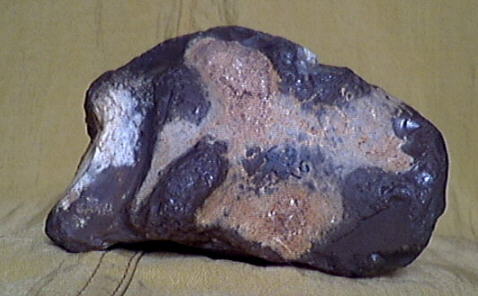
Front-lateral view (side A and side B). Size: width cm. 9.2, height cm. 5.8, thickness cm. 5.5, weight kg. 0.300. The sculpture represents a human head (side A on the left) and another of mammal (side B on the right) joined by the nape. Obtained from a nodule of silex with very much traces of the original skin, while the light zone, between the nose and the chin, is the inner color of the silex. The eye is in common to the two heads (see also drawing Fig. 8); the represented human type is similar to a presapiens. Attributed to the evolued Acheulean.
The zooanthropomorphic sculpture that I introduce (Fig. 1) is obtained from a nodule of silex, with many traces of the original skin; but however, it is not inferior to other sculptures that are completely machined from all sides, as the end result is the same.
The presence of this peel on the sculpture, at first approach, can create some difficulty of interpretation, but if we want to understand really these sculptures, we must analyze all the types, exactly like with the lithic tools, where there are those typical and "beautiful", and those atypical, and "less beautiful", that is those that to the profane do not seem not even tools.
The analysis of this sculpture is divided in 22 points:
- typology of the representation
- place of finding
- difficulty of interpretation
- chronology
- typology of the perspective
- physical anthropology
- head of the animal
- the eye
- flint nodules and pebbles
- typology of the technology
- color inside of the stone
- alluvial rolling
- intentional portrait
- composition and shape
- style typology
- religion
- bicephaly
- zoomorphic divinity
- cults
- rites
- symbol
- aesthetics
TYPOLOGY OF THE REPRESENTATION
This is a two-faced zooantropomorphic lithic sculpture, since represents joined a human head to one of animal with an only nape.
In the evolued Acheulean two-faced anthropomorhic sculptures also exist, that represent joined two human heads with a single nape.
PLACE OF FINDING
This sculpture comes from Rodi Garganico in the promontory of the Gargano (Province of Foggia, Italy). It has been found in an alluvial deposit, together with tools in silex of several cultural phases, and in great quantity, transported to the bulk by the waters.
DIFFICULTY OF INTERPRETATION
In Paleolithic artifacts, interpretation is about what is seen, and what is not seen.
We analyze what is seen, going back to the origin of the first scientific discoveries.
Jacques Boucher de Perthes lead to the attention of the scientific world the sculptures in silex and the tools of the lower and middle Paleolithic, and also tools of successive periods. As known, before that Boucher de Perthes died, the science acquired only some types of tools, and did not pronounce about the art.
Boucher de Perthes made for all his life, as today use to say, a " promotional campaign " for his discoveries, as he found great resistances for the acceptation, both of the sculptures, and of the tools. Today everything has changed; the palethnologists introduce the Paleolithic tools without fear of being contradicted. A tool displayed in a museum, or published in a book with caption is accepted from the public, but not always, rather, almost never, is understood.
Many times I have experimented, even with cultured people, who however did not know Paleolithic tools, that putting a scraper or a Levalloisian blade in their hands, they were incredulous to consider them human tools.
Trials, that instead I have made with the sculptures of the lower and middle Paleolithic, in occasion of numerous exhibitions, have demonstrated that the cultured person understands better a sculpture that a tool. Using the photograph, the difficulties of interpretation for the sculpture are, and they are several, but the first difficulty is the prejudice aiming to the refusal. If the observer does not have interest in the problem of the origins of the art, in a sculpture he sees a casually anthropomorphic or zoomorphic stone and nothing else.
My advice to the person who is really interested in the sculpture, is to make research in the Paleolithic surface deposits (in Europe they are thousand), and he will find for sure, as I do.
The same is worth also for the tools. I began to understand tools by finding them in surface deposits. The tool should be twirled in the hand like a small sculpture.
This sculpture of Rodi Garganico (Fig. 1 and following) is one of the more difficult to interpret, but also one of most interesting.
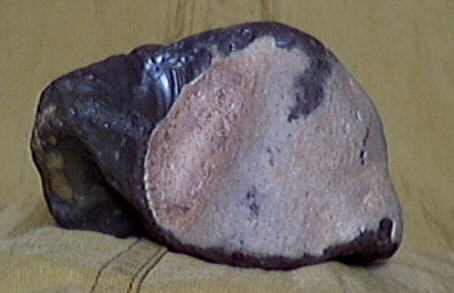
Lateral - posterior view (side B and side A) The head of mammal (side B) is almost entirely chipped, while the human head (side A), being in semifrontal view, on this side was not worked, and the rind of the nodule was left. The head of mammal has, on this side and at the tip of the snout, chipping of material from the top to the bottom, that can be seen also in the other photograph (Fig. 4), that suggests as more probable the depiction of a head of ruminant, rather than of a head of lion.
CRONOLOGY
The attribution to the evolued Acheulean is based on the affinity of the working technique (that is of the detachment of the flakes technology to give the desired shape) attributed to the lithic tools found in the area by the palethnologists during the researches of the second half of the 20th century. The attribution to the evolued Acheulean is based on the affinity of the working technique (that is of the detachment of the flakes technology to give the desired shape) attributed to the lithic tools found in the area by the palethnologists during the researches of the second half of the 20th century. Based also on attributed dating of the depicted human type, on typological affinities given to other sculptures of this cultural phase, and on the affinities of the slight fluctuation with typical tools found associated.In the Gargano, the evolued or final Acheulean has developed during the Riss glaciation and before 350,000 years ago. In the Gargano, the evolued or final Acheulean has developed during the glaciation of the Riss and before 350,000 years ago. Therefore this sculpture is not older than this date.
TYPOLOGY OF THE PERSPECTIVE
The human head must be seen in semifrontal perspective. The mammal head can be seen from three sides: on one side, from the other side, and frontally.
PHYSICAL ANTHROPOLOGY
The human head (Fig. 1, side A) is devoid of forehead, or at least has a receding forehead. The nose starts at the mouth area, and is at the center of the face which is wide. The face is frontal, and semi-frontal. It has the chin, but it seems to have a beard as well, and this can be inferred even when looking at it from below, where we can see the whole shape of the jaw.
The mandible is hollowed underneath (Fig. 3, side A), both for being evidenced, and for giving separation from the head of the animal that is joined by the nape.
This human type is similar for width of the face, and for the chin and maybe the beard, to the "presapiens" depicted in the Maribo sculpture, described in this magazine at " A bicephalic anthropomorphic lithic sculpture of the lower Paleolithic of Denmark&quoy".
Generally Homo erectus (that does not have chin) is attributed to the evolued Acheulean, but it is necessary to consider that in the evolued Acheulean, that lasted approximately 300,000 years, there are not human skeletal findings; therefore it is hypothesizable, and for me credible, that some men type presapiens with chin have been shaped, otherwise the chin would not be represented in this sculpture, like neither in that one of Maribo.
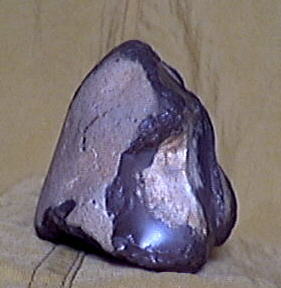
Human face (side A) To understand the human type, which I consider a presapiens, it is necessary to look at four photographs, which corresponds more or less to the rotation of the sculpture in the hand: - to see the lateral profile of the head (Fig. 1 side A), - to see this frontal face (Fig.3), - to see the face or semi-frontal head (Fig.10, painted for experimentation), - to see the under view (Fig. 5 side A), that evidences the shape of the jaw and the chin. Probably it is the representation of a man with beard. It is a carefully worked sculpture, but a portion of the face, that is scarcely influencing, since the perspective is semi-frontal, conserve the original peel of the pebble of silex.
HEAD Of THE ANIMAL
In the sculpture of lower and middle Paleolithic the representations of animal heads are much rare if compared to the representations of human heads.
The sculptures of single or two-faced heads of animals, that are few, represent great mammals (bovines, equines, felines) or birds, therefore, given the fragmentariness, typologies cannot be made.
In the mammals with horns, these are not represented, as well as the ears are not represented, both in the man and in the animal, and as well as the feet are not represented in the feminine sculptures (venuses) of the upper Paleolithic. Therefore, if the horns are not there, an important clue is lacking, to assign them to a species rather than to an other.
In beyond 40 years of researches, on a great number of finds, I succeeded with some precision to identify through the head the several human types represented in sculpture, also when there is stylistic deformation; but about the heads of animals, I can say little, as I am insufficiently documented.
The head of mammal (Fig. 1, side B), however, could be a head of lion with closed mouth and stylistically lengthened snout; but it could also be a ruminant without the horns. The questions like this can be resolved the day that other sculptures of this typology will be found. That day probably will come when the palethnologists will have exhausted their interest for the tools, and will begin to do research on the sculpture. I think and I hope that for them it will be exciting, like has been and still is for me. Material is not lacking, and it is not difficult to find, it just needs to look for it.
THE EYE
The nodule of silex of this sculpture, before being used from the man, has had a formation in two stages, in how much has been formed first a total peel, and then a second peel (equally hard) by filling earth in two hollows of the nodule over the previous peel. The man who made the sculpture, has found the nodule in such conditions.
In the photograph (Fig.1) you can see the second almond-shaped peel (see also drawing Fig. 8), which looks like an eye in common with both human and animal heads.
In the bicephalic anthropomorphic sculptures of historical ages, and in the ethnography, the eye in common for two heads is frequent.
In this sculpture's case it can be assumed that the almond shape of the second peel has been used as an eye, exactly as other forms of the nodule have been used.
Undoubtedly, the eye is an enrichment of this depiction, because generally it is constituted from a chipped hollow, that I define orbital zone.
In the sculptures in silex the eye has always been difficult to represent for technical reasons, while other parts of the face and the head were better evidenced.
In the photograph (Fig.2), in an other hollow of the animal snout there is the other filling of the second peel, that however does not have influence in the representation. However, this view is the back of the sculpture, and can be considered of secondary importance, even if the snout of the animal is more worked on this side than on the other.
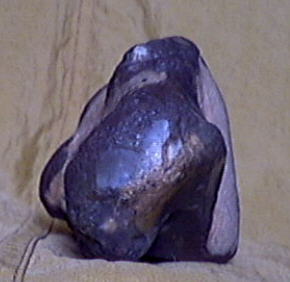
Muzzle of the animal (side B). The head of this animal is narrower than the human head, of which we can see the light peel of the flint nodule, belonging to the human head. The modeling of this carved snout is of high technical quality, when considering the sequence of flint removals with a wooden or bone striker, as it is completely rounded.
FLINT NODULES AND PEBBLES
The nodules of silex can be small or large, and have crazy shapes.
Flint nodules can be small or large, and have bizarre shapes.
Flint pebbles are generally small, elongated and narrower than round, and their shape is due to rolling from the action of sea waves on beaches.
Both nodules and pebbles of flint have a rough, opaque rind that is less hard than their interior. The flint zones in Europe can be with only nodules, or only pebbles, or, as in the area around Rodi Garganico, with both nodules and pebbles.
In the years from 1940 to 1960 in the books of "introduction to the Paleolithic", on to the trail of the news resonance about chipped sculptures found in the fifty and more preceding years, was made often reference to "nodules with anthropomorphic or zoomorphic natural shapes retouched by the man to improve the shape". There were also some photograph, even if considered as dubious shapes. These concepts were easy to accept for the inexperienced, but were devoid of every logical foundation. In fact sculpture, like tools, is inserted in very rigid typologies, where very little is left to chance.
On the use of nodules and pebbles I will give my further interpretations below, in the part concerning the "typology of the technology"
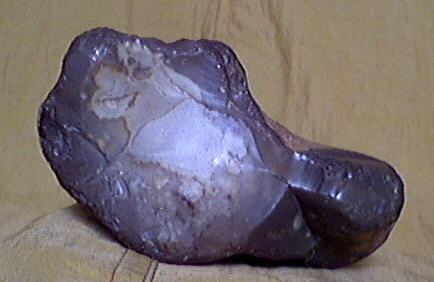
Bottom View (Side A and Side B) Side A is the mandible of the presapiens, while side B is a front part of the mammal's head. The mandible is hollowed by 5 millimeters in the middle part. The entire surface of the flint, which is seen in this photograph, has been worked, and all edges have an uninterrupted removal of flint with a width of 3 to 7 millimeters in a perfect state of preservation, except for some alluvial tumbling blows.
TYPOLOGY OF THE TECHNOLOGY
The working technique for the making of this sculpture is typical of the evolued Acheulean like that one that I have described for the bicephalic anthropomorphic sculpture of Maribo (See, in this magazine: A two-faced anthropomorphic lithic sculpture of Lower Paleolithic of Denmark).
The particularity of this sculpture (that I publish just for this purpose) is to have been obtained from a nodule of silex with bizarre shape, where it appears great part of the original peel: to the profane it could seem a sculpture whose shape is consequence of the previous shape, and therefore negative (at least for the quality aspect), if we don't realize that the final result is that one wanted.
Even among the tools it is possible to find much of the original peel of the nodule or pebble, however, if you analyze it well, the tool is perfect.
The choice of the stone for shape and dimension in order to make sculptures or tools is integral part of the technology; that is, it is the first phase of the idea to be developed.
It is recognized that, to make a two-sided tool (Fig. 7), man chose the most appropriate pebble in terms of shape and size, so that all he needed to do was to chip part of it to make it sharp and pointed, keeping intact the part to be held, which he found already made. Therefore, having a preordained mental plan, as happens even today for every work..
The same also for the sculptures: in fact, where there was the possibility to find nodules of silex with shapes that could shorten work, these were used, but the final result in the anthropomorphic or zoomorphic depiction was the same, as if the sculpture had been obtained from a pebble where this possibility was not, and therefore the work would have required more time.
Working details of this sculpture are described in the photo captions.
COLOR INSIDE THE STONE
In this sculpture (Fig. 1 to Fig. 6), the rind of the nodule of flint is light hazelnut color; while the chipped flint under the rind is dark brown. The flint within the nodule has various shades of color among which light gray prevails.
The man who made the sculpture did not know that inside he would find another color. Personally, since I study the sculpture from years, I do not give importance to the color, that is to the several colors that can have a same sculpture of silex, in how much it only interests me the shape. Who, instead, sees in photograph a sculpture in silex with several colors is disoriented; and there is also who, not knowing the technology of working, is induced to see in the colors some figures not existing, not intentional, that moreover are disturbing to understand the real representation, which is the carved shape.
Colors that were inside the nodule, that in the photo of the sculpture seem stains, are viewed by us, as by the man of the Acheulean, and, therefore, if they are disturbing for us, probably they were also for the men that have made it, and that used it in their rituals.
Red ochre has been found in Acheulean deposits; however, no burials have been found. Neanderthal man used red ochre in order to color the dead people; therefore it can be assumed that the man of the Acheulean could color the sculptures with red ochre, since we do not know what use he made of that ochre.
This is why, I introduce the photographs of this sculpture (Fig. 9 and 10) provisionally colored with a washable paint, in order to evidence the shape, for two purposes: one because the shape of the sculpture in photo results disturbed from the varied colors of the silex, and the other in order to visually imagine like it could be, painted of red ochre.
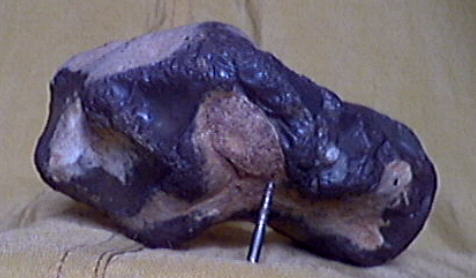
View from above (side A and side B). It is a "TECHNICAL" PHOTOGRAPHY like that previous one (Fig. 5). The iron screw is a support in order to hold the sculpture in position. In tip it coincides with the lower part of the eye, constituted by a second peel on the nodule; the photo allows to understand that in the sculpture the eye is in oblique position.
In this photography it is seen all the residual rind of the nodule of silex, while the light zone between the nose and the chin is the inner color of the silex. As can be seen by the centrality of the chin, the human head is made in semi-frontal perspective. In the drawing (Fig. 8) the view below, also corresponding to the view above (fig.6), is divided by dots to highlight that the animal's head is carved in a lateral and frontal position, while the human head is carved in semi - frontal perspective.
ALLUVIAL ROLLING
Paleolithic artefacts found in secondary deposit generally have been brought there in bulk by the alluviums, or have been rolled from the marine waves. In Liguria, where the flint does not exist and the stone is less hard, a long fluitation can cancel every trace of working, both on the sculptures, and on the tools, that become pebbles. In this sculpture from Gargano, the alluvial tumbling must have been short, in how much the damage from blows with other flints is very little, and concerns only the external edges, that have small blows on the rounded edges by human chipping.
INTENTIONAL PORTRAIT
About this zooanthropomorphic sculpture from Rodi Garganico I refer only to the human head, which I consider an "intentional portrait".
I recall that in the art history portraits are divided into two types: physiognomic and intentional.
Physiognomic portraits are sculptures or paintings of the person you want to portray; on the other hand, intentional portraits can be equally well done, but they never represent the personality of an individual, and are conventional; and I am referring to historical periods, such as: Ancient Egypt, Archaic Greece, the Middle Ages in painting, etc.
Paleolithic portrait is only intentional, and can be considered such, also, in the evolued Acheulean where, in spite of small stylistic deformations, in the anthropomorphic sculpture are evidenced anatomic details of the head of the represented human type.
COMPOSITION AND SHAPE
The human head (Fig.1, side A) is larger than that of the animal (Fig. 1, side B), and this certainly has a meaning, as in nature the head of man is smaller than that of a lion or an ox. Also the composition of two heads joined by the nape has a meaning (See Bicephaly). This sculpture, like all Paleolithic sculptures, as also "Venuses without feet", does not have a base, as instead has all the sculpture of the historical periods.
STYLE TYPOLOGY
The stylistic language is more visible in the human head than in the animal one. It is from the wide typology of human heads in sculpture that is inferred the wideness of the styles. (For an exhaustive documentation, see the site of the Museum of the Origins of Man).

From Rodi Garganico (Prov. Foggia, Italy) Size: width cm 5,5; height cm 5,2; weight kg 0,100. It has the same technique of chipping of the flakes as the sculpture that I introduce. This tool of flint of the evolued Acheulean is rigorously functional; was used the originary shape of the pebble, of which the rind as handle. Presence of residual rind is found both in the tools and in the sculptures of flint, in all the cultural phases of the lower and middle Paleolithic.
RELIGION
I think that it is a correct hypothesis to connect this bicephalic zooanthropomorphic sculpture to the religion of time, like also any artistic expression of the Paleolithic should be connected to it.
BICEPHALY
TThe bicephaly is one of the more developed topics in the study of the ancient historical religions; and, since this sculpture (Fig. 1 and Fig. 2) is bicephalic, it can be calmly presumed that it is to the origin of the bicephalic depictions of the historical ages. Same parallel can be made with the lithic tools (blades), that used to cut the skins of killed animals and the branches of the trees; it is surely assumed that they are at the origin of knives and saws.
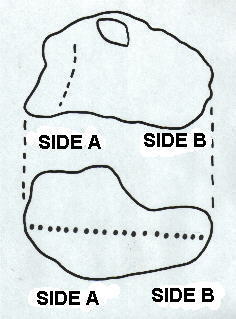
This drawing is obtained from the profile of two photographs. Are highlighted the eye in the drawing above, while in the drawing below, that is the profile of the sculpture seen from below, with the dotted line is evidenced the division in two halves of the sculpture.
The face of the human head (side A), being depicted in semi-frontal perspective, is above the dotted line, while the snout of the animal (side B) must be seen from the three sides.
ZOOMORPHIC DIVINITY
A cult connected to the animals is existing in the upper Paleolithic, and is well documented from the many zoomorphic paintings in cave; but these animals were not deities, and this is proved by the fact that in ethnography peoples with such painting do not have idolatry.
The investigation has to be made with the peoples having only sculpture, or predominantly sculpture, in historical ages and in ethnography, and then we can see that the depicted animals generally represent deities.
TThe small and little sculptures that we know about peoples with sculpture and without painting, in the Middle East and in Europe, in the Mesolithic and Neolithic, are mainly anthropomorphic, but however allow to trace a direct cultural thread from the Paleolithic to historical ages and ethnography.
The scarcity of findings is due to the fact that a lot of material has been dispersed, and also to the short length of these cultural phases which, depending on the areas, have a variable duration between 2,000 and 4,000 years. In addiction, in some zones it is difficult to establish from the tools if we are dealing with Mesolithic or Neolithic, instead the cultural continuity through the representations of deities in sculpture is more reliable, for example in Turkey, and in other zones of the Middle East.
The head of animal represented in this sculpture (Fig. 1 and following) very probably represents a deity, for three reasons: 1) because it is part of a bicephalic sculpture, that is a work made for reasons of cult; 2) because in the first historical ages and in the ethnography the sculptures representing animals, also alone, generally are deities, 3) because it is a representation in sculpture, and not in painting, and the idolatry is generally associated to the sculpture.
However they are always hypotheses, in how much, in the upper Paleolithic, we know that peoples with zoomorphic representations in painting, probably connected to the "magic", have maintained until our days a primitive stage, but we ignore their origin, that is if they are a "cultural branch" descending from the peoples with sculpture of the lower and middle Paleolithic.
To the contrary, regarding sculptures like this one, we know their origin, their uninterrupted continuity for hundreds of thousands of years, and we know that what they represent lasted until the historical eras, and persists even today in some regions of the civilized East and in ethnography.
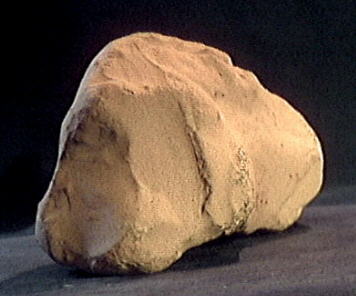
Anterior side view as starting photograph: head of presapiens (Fig. 1, side A, left); side B, right, the head of the animal.
It has been colored, both in order to let to see the shape without natural colors, and in order to simulate a hypothetical coloring in the Acheulean with red ochre for ritual use; but it gives also an idea of other sculptures realized in a type of stone of an only color, in which, because of the flowing, the traces of working are not seen.
CULTS
In Europe and in the ancient Mediterranean, from the archaic Greece to the Celts, etc., gives the written news we have, the cults connected to the bicephalic deities vary from zone to zone, as are different the names of the divinities.
It is thinkable that in the evolued Acheulean, lasted well 300,000 years, the cult connected to the bicephalic sculptures was different.
RITES
The small bicephalic sculpture displayed itself in the rites, just as the lithic tool displayed itself when it was used.
SYMBOL
This sculpture from Rodi Garganico is assumed to have been symbol in at least one cult rite.
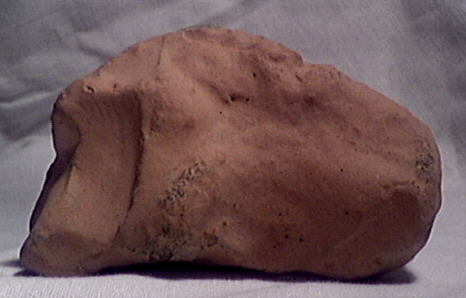
Semi-frontal view of the human head (side A to the left), which also includes a partial view of the animal's head. It is colored as Fig. 9. Note that, in photograph, colors may vary between photos due to variations in light.
AESTHETICS
When we place ourselves in front of a sculpture of the lower and middle Paleolithic, we analyze an art work by a man that was much different from us. If we have some knowledge of the working techniques of the stone, that is of how the man made tools, we can understand how he made the sculpture, even if with some approximation. Obviously, we must identify ourselves with the mentality of a man of a cultural phase different from our own.
When an ethnologist enters the tent of a primitive, if he sits on the ground, he will soil his pants, and he will not be shocked by it, since he is adapting himself to the customs of the man he is studying. The attitude of the scholar must be the same with Paleolithic art. Instead, often, the observer (that is who I hope will become a scholar of sculpture of the lower and middle Paleolithic), still considers as evaluation parameter the quality of the historical art and our contemporary art, that is its centrality, and "superiority" on the Paleolithic art.
The obstacles to an approach to the art of the lower and middle Paleolithic are many; between these, there is the belief (generally unconscious) that the art is an individual product, and also consequence of inspiration of the artist.
To my opinion, Paleolithic art, like that of every successive time, must be seen like a product that the artist makes for the others, and, in the case of the Acheulean, for the spiritual "market" of his time.
Therefore, our criterion of appraisal must enter in the context of the Paleolithic.
Copyright©2000-2002 by Paleolithic Art Magazine, all rights reserved.